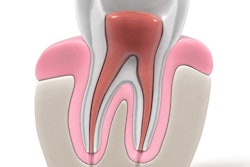
Why are some practitioners using nickel-titanium rotary instruments, and what are they good for? What's holding back the practitioners who aren't using them, and what might encourage these individuals to try something new? Researchers surveyed endodontists and general dentists and found some interesting answers.
They sent an online questionnaire to general dentists and endodontists in Saudi Arabia about their use of nickel-titanium rotary instruments. The investigators found that a large proportion of practitioners were using or aware of them, but various factors were impeding greater adoption.
"Better education, especially during undergraduate training, and lower cost may increase their usage," they reported in BMC Oral Health (November 21, 2018).
The primary author was Ahmad Madarati, PhD, BDS, an associate professor of restorative dental sciences and consultant in endodontics at Taibah University in Madina, Saudi Arabia.
Walking the nickel-titanium walk
Nickel-titanium's elasticity compared with stainless steel can make the alloy useful in the manufacture of endodontic instruments, especially rotary ones, according to the study authors. Stainless steel endodontic instruments are more resistant to fracture than the carbon steel ones they replaced but lack flexibility and the ability to maintain the root canal's original shape, they noted.
Studies have reported the superiority of nickel-titanium rotary instruments compared with stainless steel instruments for cleaning and shaping root canal systems, overall tooth outcomes, and safer and faster procedures. But despite these findings, the adoption rate of nickel-titanium rotary instruments can vary greatly between general dentists and endodontists, as well as among countries.
“Better education, especially during undergraduate training, and lower cost may increase their usage.”
To that end, the researchers of the current study sought to learn more about the rate of nickel-titanium rotary instrument usage in Saudi Arabia and related factors by surveying dental practitioners.
First, they developed an online questionnaire and sent it to academic staff members at the Taibah University College of Dentistry to ensure that the questions were clear. Next, they conducted a pilot study with 30 general dentists and 10 endodontists to finalize the questionnaire.
The investigators emailed the questionnaire to all 175 endodontists working in Saudi Arabia and also 600 randomly selected general dentists.
Among the respondents, 264 (66.8%) were general dentists, 97 (24.6%) were endodontists, 12 (3%) were students or residents in endodontic postgraduate programs, and 22 (5.6%) were classified as other. Excluding those practitioners who had never done a root canal procedure, the study included 395 respondents. Of these, almost 300 were not endodontists and 97 were endodontists, which included endodontic postgraduate students and residents.
Of the respondents, almost 72% said they used nickel-titanium rotary instruments, with a significantly greater prevalence among endodontists than nonendodontists (almost 97% versus 60%, p < 0.001). The proportion of practitioners who used these instruments increased with the greater number of years of experience working in dentistry (p = 0.001), with almost 48% with up to three years of experience using them compared with almost 86% with 7.1 to 15 years of experience (p < 0.001).
Additionally, the usage rate significantly increased with the number of root canals performed weekly (p = 0.021), ranging from almost 18% of those who performed one to three cases a week up to more than 77% of those with more than 12 cases.
Furthermore, 63% of respondents said they had used nickel-titanium rotary instruments for more than three years, which was significantly more common (p < 0.001) among endodontists (more than 77%) than general dentists (just over 54%).
Faster root canal preparation (just over 45%) was the most common reason practitioners gave for using nickel-titanium rotary instruments, followed by keeping the original canal shape (36.5%) (see table below).
| Reasons for using nickel-titanium rotary instruments | ||||
| General dentists | Endodontists | Others | Total | |
| Faster preparation | 45.7% | 44.2% | 50% | 45.3% |
| Keep canal's original shape | 15.2% | 36.5% | 25% | 24.4% |
| Cutting efficiency | 8.7% | 8.7% | 8.3% | 8.7% |
| Less operator fatigue | 6.5% | 9.6% | 8.3% | 7.9% |
| Flexible | 10.9% | 1% | 8.4% | 6.7% |
| Other | 5.9% | 0 | 0 | 7.1% |
The most common reason for not using them was the high cost (cited by more than 85%), with better education (almost 58%) cited as the most important factor that could increase adoption.
Regarding usage, 92% of respondents used nickel-titanium rotary instruments to prepare the glide path, and almost 58% used them for preparing the whole root canal system, the latter of which was significantly more common among endodontists. The majority (82%) of respondents also reported using the hybrid technique -- using different nickel-titanium instruments for instrumentation of a root canal system at least once.
Lower response
The authors noted that the study's results are limited by its response rate, which was lower than in similar studies, and that it did not include some aspects of nickel-titanium rotary instrument usage, such as the types used.
Nonetheless, the current results could be used to further survey practitioners about the specific types and brands that they prefer, according to the authors.
"Within the limitations of the current study, it can be concluded that nickel-titanium rotary instruments are relatively well-adopted in Saudi dental practice," they concluded.



















